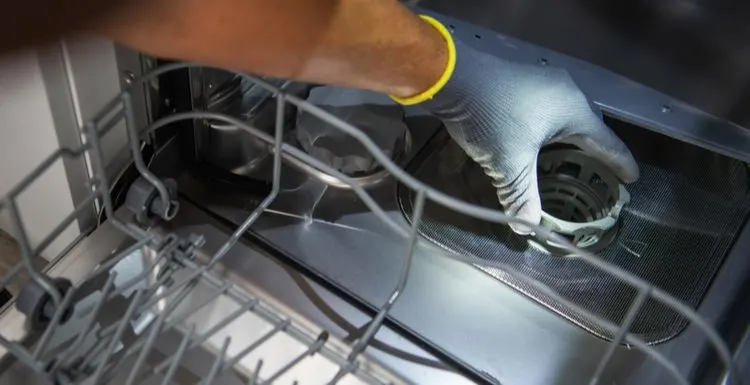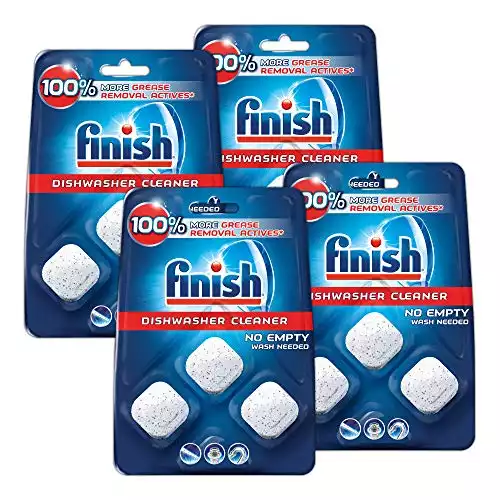Can you put Drano in a dishwasher to get rid of clogs?
Dealing with a clogged dishwasher can be a frustrating experience, as it can lead to flooding and dirty dishes, but is Drano an appropriate solution?
Should You Put Drano in a Dishwasher? A Summary
Putting Drano in a dishwasher is never a good idea, as it contains several toxic chemicals that can remain in your dishwasher for a long time.
Additionally, Drano may not solve your dishwasher issues, making it a poor solution to dishwasher drainage problems.
Can You Put Drano in a Dishwasher to Unclog It?
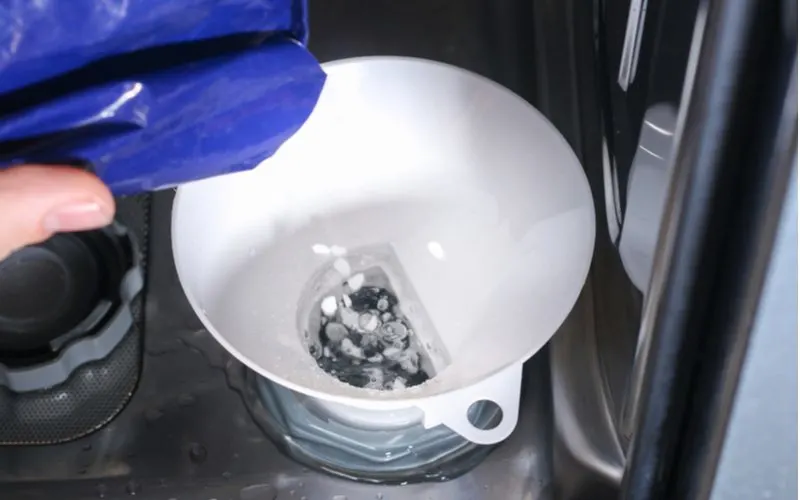
Olya Detry/Shutterstock
Drano is a popular product that can dissolve built-up debris clogging your home’s drains and plumbing.
However, it’s not designed for use on all drain-equipped appliances, especially those made of plastic.
That’s because Drano contains several toxic ingredients that can melt plastic and leave poisonous residues.
But to understand why it’s unsafe to use Drano in a dishwasher, we’ll need to take a closer look at these ingredients and their effects on dishwashing appliances.
Drano Ingredients
There are several types of Drano products. These range from foaming gels to pourable liquids. However, nearly all Drano products contain a similar set of ingredients. Some of the most prevalent of these ingredients include:
- Bleach
- Sodium hydroxide
- Aluminum
Now, bleach alone isn’t the worst thing to use inside your dishwasher. After all, when mixed with water, bleach can be a safe way to disinfect and clean your larger appliances.
However, you’ll need to ensure that you’re mixing equal parts (50% bleach, and 50% water) or diluting the bleach with a higher proportion of water. That’s because undiluted bleach is strong enough to strip paint off of walls.
As a result, bleach can damage your dishwasher’s internal components. Undiluted bleach also emits chlorine gas, something that can be toxic if inhaled.
Still, sodium hydroxide (also called lye) is probably the most dangerous ingredient in Drano products.
This acidic substance can cause severe burns if touched and may lead to lung damage if inhaled. Even more concerning, sodium hydroxide is powerful enough to eat through almost any organic substance, including the skin.
While this effect can help eliminate congealed grease and fat sitting in your drains, it can also become wildly destructive when paired with aluminum. Notably, Drano contains tiny particles of aluminum.
As such, pouring Drano into your drains causes a heat-generating reaction. The heat from this chemical mixture can get hot enough to melt PVC plumbing pipes, dishwasher pumps, and plastic parts. This reaction is so intense that it’s even featured in projects to create explosives.
How Drano Affects Dishwashers
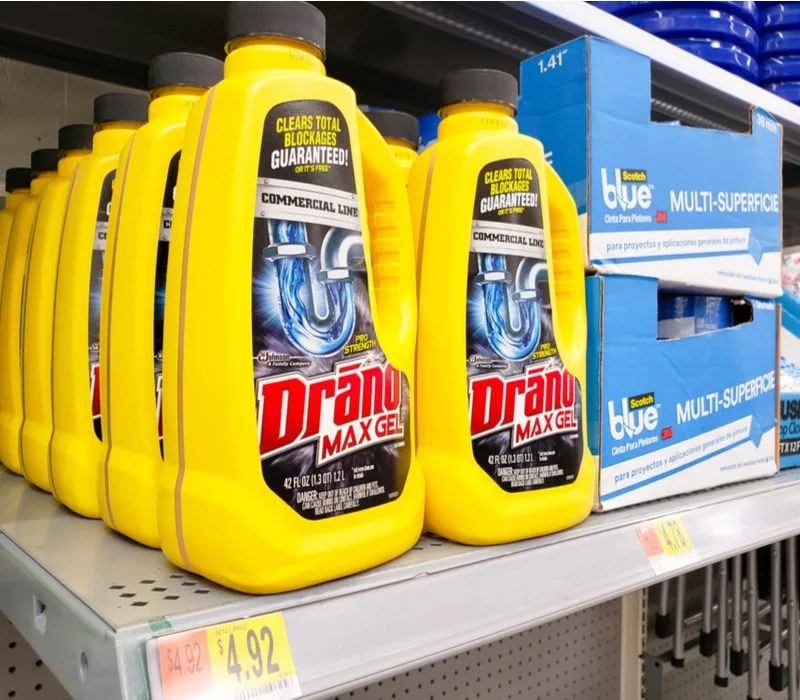
TonelsonProductions/Shutterstock
Let’s say that you pour a small amount of Drano into your dishwasher soap dispenser, close the door, and begin running a wash cycle. What’s happening inside your dishwasher?
At first, you might not notice any changes or problematic issues. But as the Drano solution begins to work its way through your appliance, it can start generating massive amounts of heat.
This heat can quickly melt the plastic components inside your dishwasher, including the drain pump.
With the drain pump melted, your dishwasher won’t be able to pump away water, leading to significant flooding. Replacing this pump costs about an average of $375, and you’ll likely need to hire a professional repair technician to get the job done.
Still, damage to internal parts and pieces isn’t the only thing that happens when using Drano in a dishwasher. The chemicals inside this product can quickly coat the inside of your appliance.
When you wash your dishes, you might be covering them with bleach and lye. Therefore, Drano affects dishwashers in two notable ways:
- It melts crucial components that keep dishwashers functional
- It leaves toxic chemicals behind that can contribute to accidental poisoning
Instead of pouring some Drano into your dishwasher when you notice a clog, try identifying the exact cause behind the drainage problems. Doing so can help you figure out a safe and effective solution.
Reasons Why Dishwashers Get Clogged
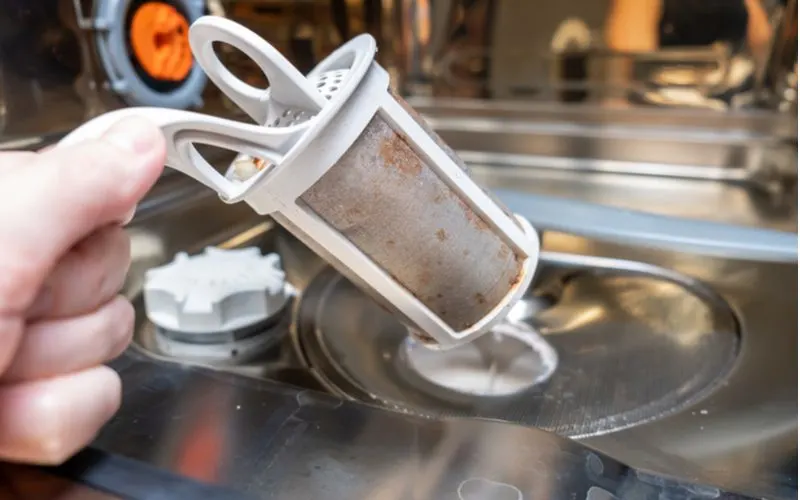
Nadezhda Mikhalitskaia/Shutterstock
You might feel the urge to put Drano in your dishwasher if it’s not draining correctly. But it’s crucial to consider the reasons why your dishwasher might not be draining before resorting to such drastic measures.
Some of the most common reasons why dishwashers get clogged include:
- Not pre-rinsing your dishes before putting them in the dishwasher
- Failing to clean the drain filter that protects the drain hose
- Hard water deposits inside the drainage pipe or hose
- Putting too much liquid soap in the dispenser
- Forgetting to remove the knockout plug in the garbage disposal
- The garbage disposal is broken or clogged
- Faulty household plumbing lines
As you can see, there are several potential reasons why your dishwasher might be clogged. Figuring out which of these issues contributes to your appliance’s drainage problems is vital to finding the right solution.
If you can’t remember the last time you cleaned your dishwasher’s drain filter, go ahead and hand wash it now with a bit of dish soap. You might be amazed at how efficiently your dishwasher drains after this point.
Of course, if your dishwasher is flooding your kitchen, you may need to contact a plumber for assistance. After all, faulty plumbing is far more challenging for the average homeowner to fix.
Frequently Asked Questions
Below, you will find some of the most frequently asked questions regarding the safety of using Drano in a dishwasher.
If you have any further inquiries, you may be able to find the answer you’re looking for here.
Can a dishwasher get clogged?
Any appliance that has a drain can become clogged. That’s because a drain is essentially a tube that carries liquids away from an area.
When solid materials, grease, or mushy leftovers enter a drain, they can quickly form a blockage that prevents liquids from flowing out.
Consequently, dishwashers can become clogged. Some of the most common causes of dishwasher clogs include food residue, congealed cooking oils, and broken garbage disposals. Forgetting to keep your drain filter clean is also a common culprit.
Fortunately, removing and handwashing this filter typically only takes a few minutes.
Be sure to refer to your appliance’s user manual or guide to keep up with maintenance tasks. Doing so can help you avoid future clogs and the flooding they often bring.
Will Drano ruin a dishwasher?
Putting Drano into your dishwasher can cause damage to your appliance’s internal components as well as the plumbing pipes attached to it. That’s because Drano shouldn’t be used on plastic, rubber, or painted metal.
It can eat through these materials, causing significant damage and necessitating expensive repairs.
Still, it might be better to simply replace a dishwasher after using Drano in it. That’s because the caustic and harmful ingredients in this product can remain inside your dishwasher for weeks or months.
Every time you wash your dishes, you may unintentionally coat them in a cocktail of toxic chemicals, leading to accidental poisoning and ill health. It’s always best to avoid using Drano in a dishwasher to be on the safe side.
What can I use to unclog my dishwasher?
There are several products you can use to unclog a dishwasher safely. For example, Finish Dishwasher Cleaner specifically removes grease and helps to clear dishwasher drain hoses.
Of course, you can also use all-natural alternatives as well. For example, applying a mixture of warm water, vinegar, and baking soda (sodium bicarbonate) may be all you need to flush away clogs and enjoy a fully functional dishwasher once again.
For an even fuller cleaning, you can follow up this vinegar wash with a lemon juice rinse. This extra level of acidity helps kill harmful bacteria and remove any stubborn remnants of food particles. A little lemon juice will also leave your dishwasher smelling like fresh citrus.
Will vinegar unclog a dishwasher?
Vinegar is a highly acidic fluid commonly used as a holistic alternative to chemical-laden cleaners.
It’s tough enough to cut through grease, and when paired with baking soda, vinegar can produce a safe chemical reaction that’s powerful enough to dissolve some drainage clogs.
Preventing blockages in your dishwasher drainage hose could be as simple as doing an empty wash with some vinegar every once and a while.
However, vinegar may not be enough to help you unclog a dishwasher. That’s because dishwasher clogs don’t have a single cause. Vinegar might be able to clear away old food remnants from your dishwasher’s hose.
So it’s not going to fix a broken garbage disposal or damaged water line. Be sure to consider hiring a plumber to help you determine the cause of your dishwasher’s drainage problems, especially if vinegar and gentle drain filter cleaning don’t solve the problem.
So, Can You Put Drano in a Dishwasher?
While it is possible to put Drano in a dishwasher, we don’t recommend it. That’s because Drano is a de-clogging agent made using several potentially harmful chemicals, including sodium hydroxide.
These chemicals can melt plastic and remain inside your dishwasher for an extended period of time. Consequently, using Drano in a dishwasher can do more harm than good.

